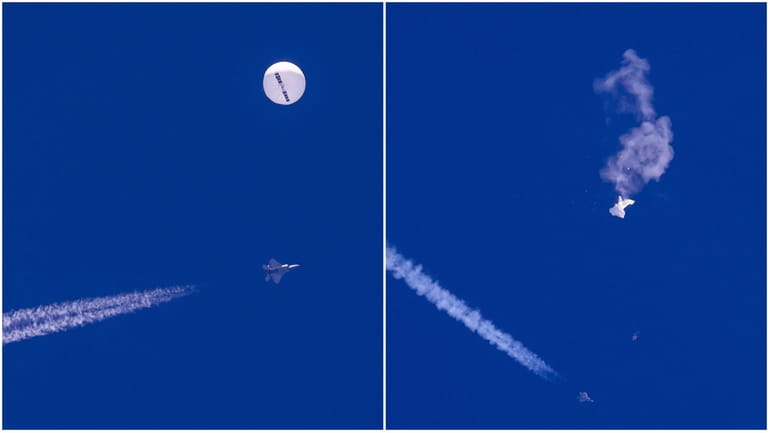Balloon signals need for new vigilance on China

Left, the Chinese balloon drifts above the Atlantic Ocean, just off the coast of South Carolina, with a fighter jet below on Saturday, and right, the balloon is shot down. Credit: AP/Chad Fish
The flight of a Chinese surveillance balloon that crossed U.S. territory for the better part of last week marked a dramatic demonstration of how relations between the two global powers became as strained as they are.
The U.S. Air Force shot it down. But that ends only some of the suspense.
For starters, Secretary of State Antony Blinken correctly and quickly canceled his planned diplomatic trip to Beijing. Talks there were supposed to cool down hostilities, but nothing could have undercut that goal quite like an incursion from China that Americans across thousands of miles could see with the naked eye.
As if to insult the public's intelligence, China called the balloon a civilian “research” or “meteorological” aircraft that somehow just happened to drift at the will of the wind. The shoot-down brought only pompous diplo-drivel from Beijing: “In these circumstances, for the United States to insist on using armed force is clearly an excessive reaction that seriously violates international convention."
Expect some information will be hidden indefinitely behind the veil of national security. The rest is emerging piecemeal.
On Monday, Air Force General Glen VanHerck revealed that the balloon was 200 feet tall with a payload weighing “in excess of a couple thousand pounds,” possibly with explosives to detonate and destroy itself. Most importantly, VanHerck added it was at least the fifth time in recent years that China breached our airspace. Euphemistically, he called it an "awareness gap."
Well, that gap better get filled — and fast. Clearly, barring TikTok from government devices to protect data and strategically updating Navy ships aren't the only measures in order on the China front.
Experts see advantages to surveillance balloons over satellites and drones also widely in use. Remotely controlled, they can stay above most airplanes. Moving slowly, they can evade radar detection. They are relatively cheap. They can take higher-resolution photos than satellites.
Still, this manner of espionage is baffling. Was this balloon’s main target of interest in Montana because that is where the Air Force has 150 missile launch sites? Was this incident a piece of Beijing propaganda to show U.S. vulnerability at a time of disagreement over control of Taiwan and China's continued alliance with Russia after the invasion of Ukraine?
Beyond balloons, our rivalry intensifies economically, technologically, and militarily. President Xi Jinping's regime has showed a relish for intellectual property theft, saber rattling toward neighboring nations, and digital espionage. Our two nations are the world's most powerful. The global stakes are high, which means the relationship with China must be carefully calibrated.
The current intrigue is a thick weave created over many years that won’t unravel quickly. For the moment, the U.S. needs to be more alert, if only to keep up.
MEMBERS OF THE EDITORIAL BOARD are experienced journalists who offer reasoned opinions, based on facts, to encourage informed debate about the issues facing our community.
